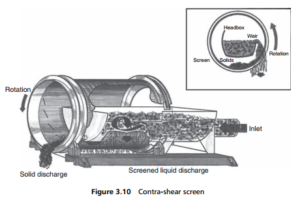0
-
An empty cart
You have no item in your shopping cart
envato-wordpress-toolkit domain was triggered too early. This is usually an indicator for some code in the plugin or theme running too early. Translations should be loaded at the init action or later. Please see Debugging in WordPress for more information. (This message was added in version 6.7.0.) in /var/www/wp-includes/functions.php on line 6121g5plus-darna domain was triggered too early. This is usually an indicator for some code in the plugin or theme running too early. Translations should be loaded at the init action or later. Please see Debugging in WordPress for more information. (This message was added in version 6.7.0.) in /var/www/wp-includes/functions.php on line 6121All of the intake screens discussed so far have operated in a stationary mode (or at least stationary whilst screening). An important group of screens rotate, screening solids continuously through that part of the screen that is submerged, with accumulated solids carried on the surface of the screen out of the water, to a zone where they may be washed off the surface into some kind of sludge collector.
The disc screen is a large frame carrying two circles of wire mesh, sealed together at their circumference, and mounted on a substantial hollow shaft. The screen sits in a flow channel, with its shaft across that channel, and submerged to just above the shaft. Solids collected on the screen surface are carried out of the water by the rotation of the screen, with heavier solids lifted by suitable buckets. The emergent screen is then washed by a spray of water, transferring the solids into a receiving trough for disposal. Screens of this type may be from 2 to 4.5 m in diameter, and can be mounted in parallel for higher flow rates. Higher flows can also be achieved by mounting the disc with just one circle of mesh across the water flow. These screens are simple in design, and are mainly used for the removal of relatively fine solids from shallow water courses.
Rotating drum screens are made from a sheet of wire mesh, mounted on the outside of a cylindrical drum and rotating on a horizontal shaft. They have some kind of washing system to remove collected solids from the drum towards the top of its rotation. A simple arrangement has the drum situated across the water flow, which thus goes through the screen and out at the side of the drum. More complex forms of rotating drum screens include the micro-strainer, which has a flow from inside the drum, through the screen, and can trap solids down to a few micrometres, because of the cake of solids that collects inside the screen, before it is washed off at the top. A different form of rotating screen is exemplified by the Contra-shear and Roto-plug designs, which do not operate with a flooded screen but are sludge thickeners and drainers ( Figure 3.10 ). The dilute suspension is fed inside the drum and the liquid drains quickly through the screen, while the separated solids fall to the bottom of the drum where they travel along the bottom, parallel to the drum axis, draining further as they do so, to leave by overflowing at the end of the drum. As these are sludge processing

screens, they find wide use in sewage treatment, pulp and paper processing, and fruit and vegetable pulp separations.